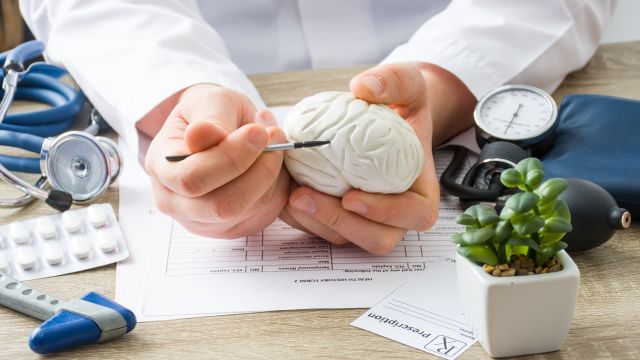Strokes occur when disease or injury suddenly disrupts blood flow to the brain or, more rarely, when blood vessels inside the brain burst. The American Heart Association estimates that each year about 800,000 Americans have a stroke, also known as a “brain attacks.” In 2021, stroke was the fifth leading cause of death in the United States.
Although over 90 percent of American adults surveyed by the Centers for Disease Control and Prevention in 2020 recognize sudden numbness on one side of the body as a symptom of stroke, just under 70 percent know all of the five main signs: sudden onset of confusion, severe headache, and trouble speaking, seeing, or walking. Fewer still are familiar with all five signs and also know to call 911 for help during these life-threatening events.
When a stroke occurs, the time it takes to get treatment is considered critical to preventing death and long-term disability. Despite medical advances in treating ischemic strokes—the kind in which blood to the brain becomes blocked—stroke prevention remains an essential public health strategy.
Some stroke risk factors are beyond our control, such as age and sex. But, experts say, some 80 percent of strokes are preventable.
How to reduce your risk of stroke
The most important modifiable stroke risk factor, experts agree, is high blood pressure, also called hypertension. This damages blood vessels and makes them more susceptible to clots and leakage.
Blood pressure is so important to overall cardiovascular health that in 2017 the American College of Cardiology and the American Heart Association (AHA) revised their guidelines to allow for earlier intervention. This guidance lowered the definition of high blood pressure from 140/90 mmHg to 130 mmHg systolic or 80 mmHg diastolic. (Systolic is the upper number in a blood pressure reading; diastolic is the lower number.) Almost half of U.S. adults were expected to fall within this definition for high blood pressure, with the most notable impact among adults under age 45.
Closely linked to high blood pressure as a modifiable risk factor is high cholesterol, or hypercholesterolemia. The “bad” type of cholesterol, known as low-density lipoprotein (LDL), contributes to a buildup of plaque that narrows your arteries and increases the likelihood of blockage, including those in the brain. This raises your stroke risk in a few ways:
- It means your heart must work harder to pump blood throughout the body, which can raise blood pressure to dangerous levels.
- The plaques themselves can rupture or form blood clots, which may break off and travel to your brain.
Even though some people recognize that having high blood pressure, high cholesterol, or both carries a greater risk for stroke, many may not understand the relationship between these risk factors and lifestyle, says Sangeeta Shah, MD, a neurologist at MercyOne Waterloo Medical Center in Waterloo, Iowa. “In my opinion, obesity and lack of physical activity are the least understood risk factors for stroke,” she says. Dr. Shah emphasizes that aiming for reaching and maintaining a healthy weight and engaging in regular physical activity are important ways to reduce your risk of stroke.
For example, one study published in the Journal of Clinical Medicine in 2020 suggested that losing a relatively modest amount of weight can have benefits and that it’s important to maintain the weight loss. The study included people aged 45 to 64 years who were overweight or obese and at increased risk for cardiovascular disease. It showed that losing between 5 percent to 10 percent of body weight (10 to 20 pounds if you weigh 200 pounds) and maintaining this weight loss for two years was associated with significantly lower cardiovascular disease (CVD) risk factors, including almost 10 mmHg lower systolic blood pressure and lower ten-year risk for fatal CVD.
You can help manage your weight by eating a healthy diet high in fiber and full of fruits and vegetables, legumes, whole grains, and lean meat—and low in sugar, salt, saturated fats, trans fats, and cholesterol. Consider the DASH diet, an eating pattern that may be helpful for lowering blood pressure.
Tracking your diet and physical activity can help build healthy habits. The Sharecare app (available for Android and iOS), features trackers for both at your fingertips.
More ways to prevent a stroke
In addition to modifying your diet and exercise plan, other strategies for lowering your stroke risk include the following:
- Quitting smoking, because smoking can increase blood pressure and damage your heart and blood vessels.
- Limiting alcohol intake, since even moderate drinking can raise your blood pressure, increase levels of triglycerides (a fat in your blood that can contribute to hardening of the arteries), and increase your risk for stroke. The CDC recommends that men have no more than two drinks per day, while women should have no more than one. A study of almost 400,000 people published in the journal JAMA Network Open in 2022 showed that even light levels of habitual alcohol consumption were associated with modestly increased cardiovascular risk, and that this risk increases exponentially as alcohol intake goes up.
- Controlling certain medical conditions, such as diabetes, which raises the risk of both heart disease and stroke.
Being able to identify the signs of mini-strokes, also known as transient ischemic attacks (TIAs), is helpful, as well. These strokes can produce symptoms similar to those of full-blown strokes, but usually carry no lasting effects since blood supply to the brain is blocked only temporarily. Having a TIA, however, may increase your risk for future strokes.
How to prevent a stroke in younger people
Your chance of having a stroke roughly doubles every 10 years after age 55, according to the CDC. But trends show that strokes are increasing among young adults in the U.S. Among people aged 20 to 44 years, the number of strokes was almost 1.5 times higher in 2015 compared to 1993, according to a review of studies published in the American Journal of Preventive Cardiology in 2020.
According to Shah, the steady rise in this younger age group can be partly attributed to the same lifestyle factors that put older adults at risk for stroke, namely obesity, high blood pressure, high cholesterol, and lack of exercise. Additionally, she says, many young people don’t see healthcare providers regularly. They may also experience high stress levels, due to factors including family obligations or financial concerns, that can raise their stroke risk.
Ultimately, no matter your age or the type of stroke, regular medical checkups play an important role in reducing risk. “Everyone should have physical checkups to make sure all of their risk factors are appropriately controlled,” Shah says.






